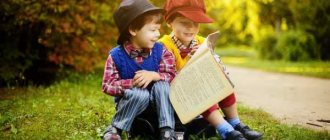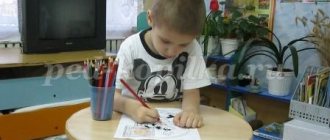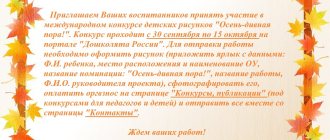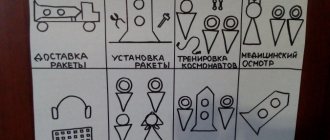Analysis of classes in kindergarten: methodological aspects of implementation
Analysis of classes in kindergarten: methodological aspects of implementation
The main task of a modern kindergarten is to help families raise a harmoniously developed child: inquisitive, physically healthy, capable of empathy, and understanding the value of friendship and family. Therefore, a teacher of a preschool educational institution (DOU) is required to be in the context of what is happening in modern methods of working with children. And in order to find out whether this requirement successfully correlates with the educational process, classroom analyzes are regularly carried out in kindergartens.
Goals and objectives of analyzing a lesson in a preschool educational institution Monitoring a lesson in a preschool educational institution can be carried out in two types: self-analysis, or reflective analysis; analysis by those present, or problematic, which is carried out by colleagues, methodologists, and the management of the preschool educational institution. This is interesting. Analysis of classes in the senior and preparatory groups can be carried out by primary school teachers who will work with children in grades 1–4. In this case, the purpose of attending the lesson will be to assess the level of preparation of children for school. Self-analysis is carried out by the teacher in order to identify methodological shortcomings, organizational miscalculations, as well as determine the level of children’s mastery of the curriculum. Analysis of the lesson allows you to see methodological and organizational failures in the work of the teacher. Problem analysis is intended to diagnose: the quality of the implementation of the educational program that determines the principles of operation of a particular kindergarten; the effectiveness of the methods used to work with children; the level of professional skill of the teacher in selecting material and presenting it using techniques for interacting with children; compliance of the level of knowledge, skills and abilities of preschoolers with the accepted requirements designated by the Federal State Educational Standard. The tasks of diagnosing classes in kindergarten are: assessing the accuracy and realism of the lesson goal (that is, the ratio of time for implementation with the level of preparedness of the children, their abilities and capabilities); tracking the integration of different areas of education within one lesson (that is, fulfilling one of the main requirements of the Federal State Educational Standard, based on combining types of activities from different areas of education - drawing in mathematics, or counting in physical education); psychological validity of the content of the material and the form of the lesson (implementation of an integrated approach to choosing a topic through different types of interaction based on the joint activities of children and the teacher - games, conversations, etc.); monitoring the progress of the lesson (evaluating both the content of the selection of material and organizational aspects, such as motivating children to work, maintaining interest throughout the lesson, summing up); the level of children’s mastery of the material; methodological literacy of the teacher (creating a situation of success for each child in the classroom, implementing an individual approach, that is, the ability to both see and “feel” each student). Techniques for conducting analysis To monitor a lesson, three types of techniques are used. Verbal techniques Analysis of a lesson involves an oral presentation in the form of a report at the teachers' council (small if the analysis is carried out immediately after the lesson, or large if monitoring is part of the development of a methodological problem by a senior educator about the progress of work in a preschool educational institution). With the exception of cases when, when conducting competitions of pedagogical skills, the teacher is required to compile a methodological folder, including, among other things, several written self-analysis of classes. In general, the completed tables according to the analysis criteria are presented orally. An oral presentation of the analysis is made on the basis of the monitoring map. Observation This is the main way of obtaining data for analysis. With the help of observation, the person analyzing the organization of direct educational activities (DEA) makes a conclusion about: the methodological equipment of the lesson, that is, the correspondence of the set of visuals to the topic, the level of the children (for the first younger group, an illustration about spring with flying birds and melted snow is quite enough, but pictures of sowing garden and cereal crops will be superfluous); psychological climate in the lesson (for example, does the teacher find the “key” to all children, including hyperactive, inattentive ones; for example, in the older group such children can be involved in reading poems or riddles that illustrate the topic); methodological knowledge of the teacher, that is, how the teacher varies the methods of interaction with the children depending on the complexity of the material, the experience of the children or their general physical condition (for example, in a lesson on speech development after a physical education lesson, you should not give children an outdoor game as a physical education lesson, it is better limit yourself to finger gymnastics). Practical techniques for analyzing lesson notes It is understood that before attending the lesson, the psychological and pedagogical characteristics of the children in the group and the self-analysis of the types of direct educational activities will be studied. After the lesson, the teacher provides the inspector with a summary of the lesson, which is considered not only from the point of view of the selected materials for work, techniques, but also from the point of view of the correct execution of such documents (indication of the topic, goals, objectives, description of the course of the lesson, expected results). This is interesting. Indicating the expected results in the lesson notes allows the examiner to adequately evaluate the techniques chosen for interaction in the lesson. For example, if one of the expected results was memorizing a new rhyme, then this fully justifies the fact that the poem in class was repeated 2-3 times at all stages of the lesson, and not just once in the introductory part, which is enough to get acquainted with the topic. Analysis of the notes allows you to see the consistency of the structure of the lesson and the consistency in the choice of methodological techniques for developing a specific topic. What types of activities are analyzed. Monitoring is carried out in open classes or ongoing ones, regardless of their educational focus: speech development; formation of elementary mathematical concepts (FEMP); formation of a holistic picture of the world (FCCM); music activity; speech therapy session; choreography; physical training; basics of literacy. This is interesting. Schemes for analyzing physical education and choreography will differ in content from diagnostics in other classes. In addition, it is mandatory to conduct an analysis of educational activities within the framework of: walks; matinee; entertainment. This is interesting. If in classes of direct educational activities, special emphasis in the analysis is placed on the organization of cognitive activity (for example, conducting a didactic game) and physical development, then in the diagnosis of matinees and entertainment, an important element of analysis is social and communicative activity. According to the Federal State Educational Standard, not only activities are analyzed, but also entertainment and walks. Analysis schemes Monitoring schemes may differ in structure and goals depending on the indicators being studied: general analysis, which gives a general idea of the activity, which is more subjective in nature; pedagogical analysis, designed to give a detailed description of the form and content of the lesson, as well as the activities of the teacher and children, having a point system for assessing each analyzed criterion; psychological diagnostics, which allows, through organized educational activities, to assess the emotional contact of the teacher with the audience of children; analysis of routine moments (usually includes monitoring of the first half of the day). General analysis is carried out as an element of constant methodological control in preschool educational institutions, as well as to evaluate the activities of student trainees. Pedagogical analysis is a mandatory event during the certification campaign for teachers, and is also considered an integral element of the package of documents for participation in pedagogical excellence competitions. Algorithm for conducting a general analysis of a lesson in a preschool educational institution The topic of the lesson. The date of the. Full name of the teacher indicating regalia. Name of the group and age of the children. What goals and objectives are key in the lesson. Compliance with the structure of the lesson with the Federal State Educational Standard, that is, the presence of an introductory part, a main part, stages of consolidation and summing up. How well the selected techniques and tasks correspond to the level of development of the children (give an assessment for each type of work within each stage of the lesson). Is an individual approach implemented in the lesson? Evaluation of the teacher’s actions, indicating both positive and negative aspects of the work. Moreover, it is important to summarize the activities of the teacher, including from the point of view of the children, that is, which selected types of work they liked and which they did not and why. Results for the lesson as a whole with an assessment of the teacher’s personal qualities that contribute to or hinder the implementation of the educational process. For example, if the teacher is phlegmatic by temperament, and the majority of children are choleric, then perhaps the change in types of activities does not occur very dynamically. An example of an analysis of a lesson on speech development Date: 11/26/16. Group: “Sun” Teachers: Kolmychenko A.I., Pavlova S.V. Lesson: Speech development, drawing. Topic: “Give Good” Goal: developing ideas about peace, love, goodness. The lesson I watched was prepared and conducted in accordance with the group program and the volume of program content. The lesson corresponded to the level of development of children in this group. Characteristics of the teacher’s activities: when working with children, teachers used the following techniques to solve the assigned tasks: visual techniques (showing illustrations, samples), verbal techniques (the teacher’s story, children’s answers), practical techniques (drawing). The teachers were attentive to taking into account the individual characteristics of the children when preparing the lesson. Characteristics of children’s activities: children easily learned the new material presented. The atmosphere of the class was favorable. The children were active in dialogues with teachers and attentive in mastering new material. It was also noticeable that the children experienced positive emotions throughout the lesson: joy, surprise, fun. During the lesson, the optimal balance between dialogic and monologue communication between teachers and children was observed. The appearance of the teachers was neat, neat, and encouraged the children to communicate and work in class, especially since costume elements were used. There was a psychological distance “nearby”, i.e. children felt comfortable interacting with teachers. The conditions met sanitary and hygienic requirements. The activity, in my opinion, can be considered productive and useful for both children and observers.
ov/ General analysis is an element of the constant methodological control of the preschool educational institution Table: diagram of the detailed analysis map Purpose of attending the lesson: Full name of the teacher, regalia: Date: Lesson: Topic: No. Indicators Points 1 Goal setting Correspondence of the purpose and objectives of the lesson to the topic and selected content . Targets have been defined. 2 Preparation for lesson 2.1. The ability to create a “skeleton” of a lesson and use it creatively (make changes to the course of the lesson). 2.2. Selection of demonstration and handout material, modern teaching aids. Their rational use in the classroom. 2.3. Preliminary work with children (if necessary). 3 Lesson structure 3.1. Clear tracing of the structural parts of the lesson. 3.2. Each part of the lesson plays a specific role in solving problems. 3.3. Optimal allocation of time for each part of the lesson. 4 Contents of the lesson 4.1. The content of the lesson corresponds to the program material. 4.2. The material being studied is accessible and corresponds to the age characteristics of children. 4.3. There is a connection between the studied material and practice; there was reliance on the life experience of children in order to develop cognitive activity and independence. 4.4. The connection between the material being studied and previously covered material, the integrative nature of the lesson, and the connection with other classes can be traced. 5. Compliance with sanitary and hygienic requirements 5.1. Satisfaction of children's physical activity (rest during the lesson). 5.2. Changing poses during class. 5.3. Monitoring the correct posture of children while working at tables. 5.4. Compliance of the duration of the lesson with sanitary and hygienic requirements. 6. Creation of the cognitive sphere of the lesson The lesson or most of it takes place on a high emotional and intellectual high, as a result a feeling of satisfaction from teamwork is born, a desire to repeat and consolidate success. 7. Teaching methods used 7.1. Children's search activity is stimulated using various methods. 7.2. The teacher does not forget about the methods that motivate the learning process. 7.3. Methods of self-organization of cognitive work of preschoolers are skillfully applied. 8. Organization of children's activities 8.1. The activity is developmental in nature in the communicative, creative and cognitive spheres. 8.2. Children accept creative and problematic situations in classes, which indicates the degree of trust between the teacher and students. 9. Interaction between the teacher and children 9.1. The teacher encourages students’ initiative, creates conditions for emotional openness and trust. 9.2. The teacher, together with the students, creates opportunities for personal self-realization. 10. The teacher’s speech and its meaning in the lesson 10.1. The teacher’s speech enriches the lesson material. 10.2. In monologues, the teacher thoughtfully uses pauses, rhetorical and problematic questions, and creates emotional climaxes. 10.3. The emotional and intellectual richness of speech supports the cognitive activity of students and encourages creativity. 11 Educational side of the lesson. 11.1. The teacher carries out moral, aesthetic, labor education, etc. through the content of program material, methods and forms of work. 11.2. The teacher (his demeanor, speech, professional skills) serves as a positive example to follow. 11.3. A value-based attitude between the teacher and students is developed and vice versa. 12 Monitoring and correction of children’s activities. 12.1. Control is carried out in the system, the activities of students are unobtrusively adjusted. 12.2. Preschoolers have the skills of self- and mutual control. 12.3. Children master simple methods of self-analysis and reflection. 13 Lesson effectiveness 13.1. Everyone has mastered the lesson material, and the prospects for further learning have been determined. 13.2. The pupils received an incentive for independent cognitive activity. 13.3. The educational effect of the lesson is high (from the acceptance of moral norms and responsibilities to the desire to understand oneself and one’s place in the world). Total points: Evaluation criteria: 0 points. – the indicator does not appear; 1 b. – manifests itself partially; 2 b. – manifests itself in full. 60–70 b. – optimal level; 35–48 b. – permissible level; 49–59 b. - enough level; less than 50 b. – critical level. Lesson attended: Table: diagram of psychological analysis of a lesson in kindergarten Questions for consideration Yes No Partially Note Psychological monitoring of children’s activity: children are active in class; children perceive the teacher positively; During the lesson, the children are in a good mood. Psychological and pedagogical assessment of the lesson: organizational level of the lesson (general mood in the lesson, use of games as elements of organization); the ratio of monologues and dialogues in children’s communication with the teacher (whose monologue/dialogue speech predominates or is equally correlated); compliance of work methods in the classroom with the age-related psychological and physiological development of children (does the teacher provide an individual approach when conducting a lesson). Psychological diagnostics of the teacher’s activity: the presence of a distance between the teacher and the children (“above”, “under”, “next to”, “together”); sociability (the ability to find an approach to the group and to each child); the teacher’s appearance (posture, facial expressions, pantomime, style and restraint in clothing and hairstyle). Date of analysis: Group: Educator - Full name: Inspector - Full name: Files of schemes for analyzing classes of different educational orientations With schemes for analyzing GCDs of different directions, routine moments (walks, organization of the first half of the day), as well as the rules for attending classes and events can be found in the selection of preschool education methodologist N.V. Nikolaeva, presented here Video: example of a general analysis of a lesson on moral and patriotic education of preschoolers Video: analysis of a lesson in a preparatory group by primary school teachers in order to determine the level of readiness of children to school Analysis of classes and other types of educational activities in kindergarten is an obligatory element of the methodological work of teachers. The monitoring schemes recommended by the Federal State Educational Standard allow for a comprehensive study of the effectiveness of the implementation of the educational program, as well as the effectiveness of the methods of interaction with children chosen by the teacher. All this allows us to improve the quality of the educational process aimed at the harmonious and comprehensive development of preschool children. Author: Natalya Vasylishin Print Higher philological education, 11 years of experience teaching English and Russian, love for children and an objective view of modernity are the key lines of my 31-year life. Strengths: responsibility, desire to learn new things and self-improvement. Rate this article: 54321 Share with friends! Similar posts: Methodological aspects of carrying out work before bedtime in kindergarten How to analyze an open lesson in kindergarten Methodological foundations for preparing and conducting games on traffic rules in kindergarten Yandex.Direct Courses for preschool teachers! Distance courses! Diploma! According to the Federal State Educational Standard! FIPKiP! Recruitment is underway! All around Russia! fipkip.ruAddress and telephone Contest of educators. Participation from 25 rubles! All-Russian competition (Moscow). Diploma in 1 minute! Only prizes! Publications! apr-el.ru Official website of AK Moravia Sochi Sale of apartments with sea views. Promotion – Discount for cash payments! sochi-moravia.comAddress and telephone Project declaration on the advertised website Courses for teachers of preschool educational institutions Federal State Educational Standards Distance. Retraining courses (520 hours + diploma) and PDA (72 hours + certificate) for preschool teachers eduregion.ruAddress and telephone Interesting In Russia, a new tax is being introduced for village residents and summer residents Native advertising What should not be done when traveling? 7 proven tips Native advertising The best smartphone for those who love sports has been named Native advertising Open lesson in kindergarten: protocol, title page, script Corners in kindergarten: design in accordance with the Federal State Educational Standard + photo Decoration of a group in a kindergarten with your own hands in accordance with the Federal State Educational Standard, zoning, design + photo Relap Conversation in the senior group: methods of preparation and conduct Previous article Conducting conversations in the preparatory group: card indexes and methodology Next article Similar articlesMethodology for conducting self-analysis of classes in kindergartenNATALYA VASILYSHIN 07/10/2018Self-education of the preparatory group teacher: important aspects of the work methodologyNATALYA VASILYSHIN 07.06 .2018 Methodological aspects of the implementation of the program “From birth to school” in the senior groupNATALYA VASILYSHIN 05/29/2018 Do-it-yourself didactic material for kindergartenGALINA ROSTISLAVOVNA SALNIKOVA 04/11/2018 Program “From birth to school”: not forced, but natural development of the childNATALIA VASILYSHIN 04/06/2018Program " Kindergarten 2100": educational process without stress and overloadNATALYA VASILYSHIN 04/04/2018
https://melkie.net/metodicheskie-razrabotki/analiz-zanyatiya-v-detskom-sadu.html#hcq=NickvXq
Analysis of classes in kindergarten: methodological aspects of implementation





